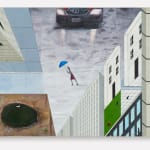-
Artworks









The Blue Umbrella, 2022
Acrylic and mixed media on canvas51 1/2 x 66 3/4 x 1 3/4 in.
130.8 x 169.5 x 4.4 cm$ 125,000.00Further images
-
(View a larger image of thumbnail 1
)

-
(View a larger image of thumbnail 2
)

-
(View a larger image of thumbnail 3
)

-
(View a larger image of thumbnail 4
)

-
(View a larger image of thumbnail 5
)

-
(View a larger image of thumbnail 6
)

-
(View a larger image of thumbnail 7
)

-
(View a larger image of thumbnail 8
)

-
(View a larger image of thumbnail 9
)

Combining reverse, isometric, and conventional perspectives, Mernet Larsen casts everyday scenarios into a vertigo-inducing version of reality akin to our own. In 'The Blue Umbrella,' a lone figure traverses an...Combining reverse, isometric, and conventional perspectives, Mernet Larsen casts everyday scenarios into a vertigo-inducing version of reality akin to our own. In "The Blue Umbrella," a lone figure traverses an urban street scene that plays with our understanding of what spaces are indoor, outdoor, above or below our protagonist. The ground the figure walks along can be read as pavement, "outer-space," or even sky.
Larsen is interested in depicting "inhospitable nature," juxtaposing an eerily perfect manicured lawn with the more naturalistic, void-like pond in the bottom left of the painting. The enormous car looming over the figure adds to this sense of foreboding. Larsen notes that she wished to paint "the facade of the car" - rendering the car not as a realistic object in scale, but as one's vision of a car barreling towards you in traffic.
While in conversation with Hans Ulrich Obrist, Larsen remarked on her 'vertigo' effect, “It’s just disorientation. If the perspective is in reverse, you’re completely disoriented because you are the vanishing point. When I first started using reverse perspective, I used myself as a vanishing point. Whatever I was looking at was getting progressively larger as it went away. When you, the viewer, look at that–and when I look at it and am working on it–you feel slightly sick. You feel disoriented. I want to keep you off balance so that you don’t know where you are in it. Again, you’re not a spectator. It’s not a stage, not a screen, not a film.” -
(View a larger image of thumbnail 1
)








